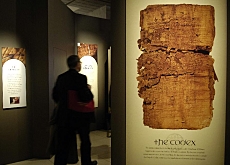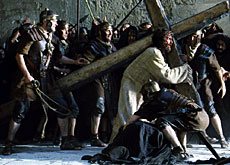Swiss translation shows Judas in a positive light

An ancient manuscript, translated by a Swiss expert, shows that the disciple who betrayed Jesus was actually doing the bidding of Christ himself.
The 1,700-year-old copy of the “Gospel of Judas” contends that the most vilified man in Christendom understood Jesus better than any of the other disciples.
An English translation by Rodolphe Kasser, one of the world’s leading Coptic scholars, was unveiled by the National Geographic Society, and the papyrus manuscript went on display at the society’s museum in Washington on Friday.
Work on the document started in Switzerland in 2001, after the Maecenas Foundation for Ancient Art in Basel acquired it from an antiquities dealer and Kasser began translating it from the Coptic.
Several years of scientific tests followed, including radiocarbon dating, ink analysis and multi-spectral imaging, which showed the document was copied down around the year 300.
In it, the man whom Dante placed in the lowest level of hell emerges as the only person in Jesus’s inner circle who understood the Messiah’s desire to shed his earthly body.
Jesus quoted
The document describes itself as “the secret account of the revelation that Jesus spoke in conversation with Judas Iscariot”. It later quotes Jesus telling Judas: “You will exceed all of [the other disciples] for you will sacrifice the man who clothes me.”
Various scholars have already commented on the manuscript. Donald Senior, president of Catholic Theological Union in Chicago, said the document revealed the diversity and vitality in early Christianity.
“The question [is] does this tradition, this alternative story… have a claim that in some sense is equal to the rival claim of the gospel tradition?” Senior said.
It is not known who wrote the Judas gospel. The New Testament of the Christian Bible contains four gospels – of Matthew, Mark, Luke and John – but many more so-called apocryphal gospels were written in the first centuries after Christ’s death.
In the Bible, Judas is portrayed as the quintessential traitor, accepting 30 pieces of silver to betray Jesus by identifying him to Roman soldiers.
Treachery
The gospel of Matthew says Judas quickly regretted his treachery, returned the silver and hanged himself.
The leather-bound copy of the gospel was written in Coptic script on both sides of 13 sheets of papyrus, and spent most of the past 1,700 years hidden in a cavern in the Egyptian desert, according to the National Geographic Society.
The Society said the document was probably copied from the original Greek manuscript around the year 300. It was discovered in the 1970s near Minya, Egypt, but spent 16 years in a safe deposit box in the US, which hastened its decay.
When it finally reached Switzerland, the papyrus had crumbled into hundreds of pieces and had to be painstakingly reconstructed.
swissinfo with agencies
The papyrus of the Gospel of Judas was found near Minya in Egypt in the 1970s.
It was acquired by an Egyptian antiquities dealer who tried to sell it at least twice before storing it in a safe deposit box in New York for 16 years.
It was eventually bought by a Zurich-based dealer, Frieda Nussberger-Tchacos, in 2000, who passed it on to Maecenas Foundation for Ancient Art in Basel for translation.
The Foundation engaged Coptic expert Rodolphe Kasser to do the translation.
After a series of scientific tests, the papyrus was judged to be an authentic Egyptian document of ancient origin.

In compliance with the JTI standards
More: SWI swissinfo.ch certified by the Journalism Trust Initiative



You can find an overview of ongoing debates with our journalists here. Please join us!
If you want to start a conversation about a topic raised in this article or want to report factual errors, email us at english@swissinfo.ch.